ICICI Lombard General Insurance Bundle
Who Really Owns ICICI Lombard?
Understanding the ownership structure of a company is crucial for investors and stakeholders alike. The ICICI Lombard General Insurance SWOT Analysis reveals key insights, but who ultimately controls this major player in the Indian insurance market? Delving into the ICICI Lombard ownership structure provides a clearer picture of its strategic direction and future prospects.
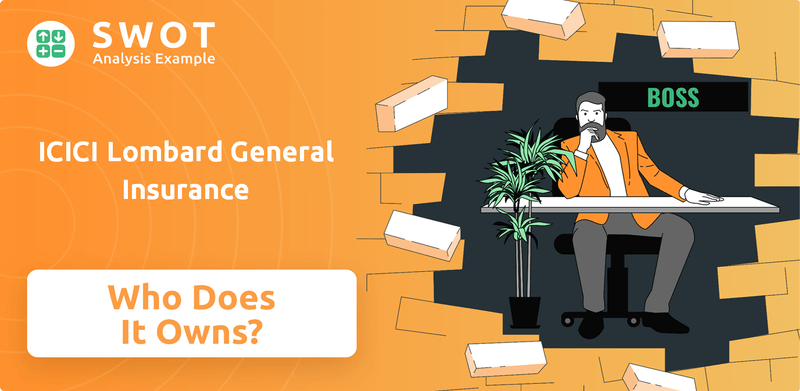
ICICI Lombard, a leading general insurance company in India, has seen its ownership evolve significantly since its inception. From its roots as a joint venture to its current status as a publicly listed entity, the ICICI Lombard shareholding pattern has undergone considerable changes. Examining the ICICI Lombard shareholders and major stakeholders offers valuable insights into the company's governance and strategic decisions. Understanding who owns the majority stake in ICICI Lombard is key to assessing its long-term value.
Who Founded ICICI Lombard General Insurance?
The establishment of ICICI Lombard General Insurance Company Limited marked a strategic joint venture, bringing together ICICI Bank Limited and Fairfax Financial Holdings Limited. This partnership aimed to combine ICICI Bank's strong domestic network in India with Fairfax's global expertise in insurance and reinsurance. The structure of ICICI Lombard ownership was designed to leverage the strengths of both entities from its inception in 2001.
At the outset, the ownership structure of ICICI Lombard saw ICICI Bank holding a majority stake, while Fairfax Financial Holdings held a significant minority stake. This arrangement was in line with the regulatory environment in India, which governed foreign ownership in the insurance sector. This initial setup laid the groundwork for ICICI Lombard's operations.
The early agreements between the founding partners likely included provisions for strategic decision-making, operational control, and capital infusion. There were no widely publicized ownership disputes or buyouts in the initial stages, as the joint venture was built on a foundation of mutual strategic interests. The founding team's vision, driven by ICICI Bank's diversification goals and Fairfax's interest in the Indian market, was reflected in the collaborative distribution of control, with ICICI Bank leading in the Indian market. This dual-entity foundation provided a strong base for ICICI Lombard to establish itself in a competitive market.
Understanding the initial ownership structure of the ICICI Lombard is crucial for grasping its journey. The partnership between ICICI Bank and Fairfax Financial Holdings was fundamental. This collaboration was essential to the company's early success in the Indian market.
- ICICI Bank held a majority stake, reflecting its dominant role as the Indian partner.
- Fairfax Financial Holdings held a substantial minority stake, bringing in global insurance expertise.
- The joint venture structure allowed ICICI Lombard to combine local market knowledge with international best practices.
- The initial ownership setup was compliant with Indian regulatory requirements for foreign investment in the insurance sector.
ICICI Lombard General Insurance SWOT Analysis
- Complete SWOT Breakdown
- Fully Customizable
- Editable in Excel & Word
- Professional Formatting
- Investor-Ready Format
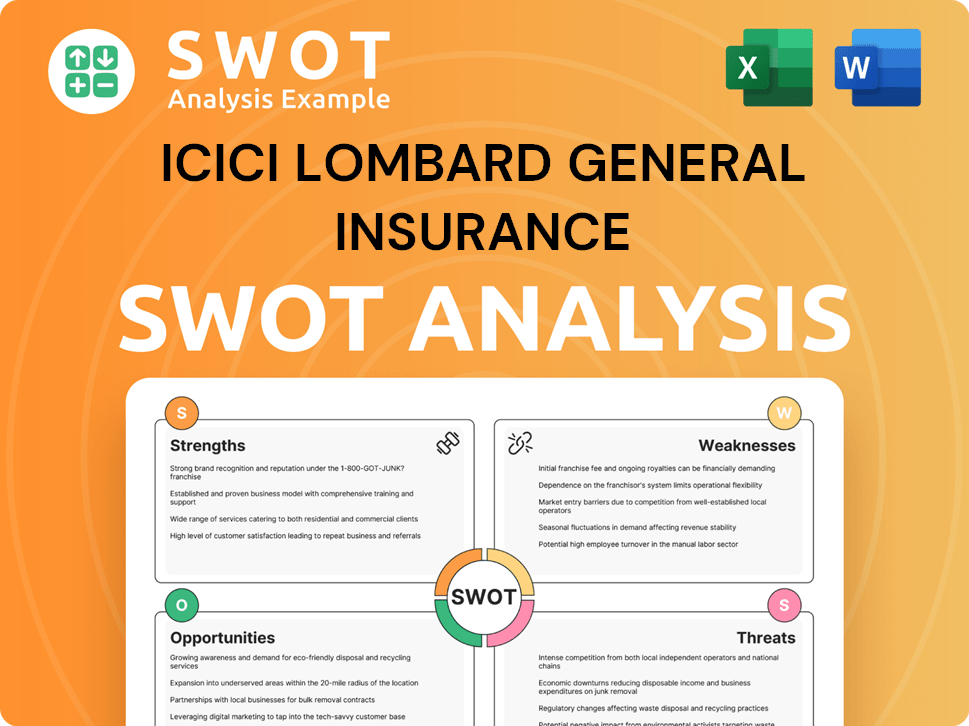
How Has ICICI Lombard General Insurance’s Ownership Changed Over Time?
The ownership structure of ICICI Lombard General Insurance Company has significantly evolved since its inception, transitioning from a joint venture to a publicly listed entity. The Initial Public Offering (IPO) in September 2017 was a pivotal event, with ICICI Bank and Fairfax Financial Holdings diluting their stakes. The IPO, which was oversubscribed, marked a shift towards broader public ownership. This move reflected strong investor confidence in the insurance provider.
Post-IPO, ICICI Bank remained the largest shareholder, aligning with its strategic interests in the insurance sector. Fairfax Financial Holdings gradually reduced its stake, eventually exiting as a major shareholder. These changes have shaped the company's trajectory, increasing transparency and influencing its strategic direction toward maximizing shareholder value. The dilution of founder stakes and the entry of diverse institutional investors have broadened the company's capital base.
| Key Event | Impact on Ownership | Stakeholders Involved |
|---|---|---|
| Initial Public Offering (IPO) - September 2017 | Dilution of stakes by ICICI Bank and Fairfax Financial Holdings; Public listing | ICICI Bank, Fairfax Financial Holdings, Public Shareholders |
| Post-IPO Shareholding Adjustments | ICICI Bank maintained a significant stake; Fairfax exited | ICICI Bank, Institutional Investors, Public Shareholders |
| Ongoing Shareholder Dynamics | Fluctuations in holdings by institutional investors | Institutional Investors, Mutual Funds, Public Shareholders |
As of March 31, 2024, ICICI Bank Limited holds approximately 48.01% of ICICI Lombard. The remaining shares are held by public shareholders, including institutional investors, mutual funds, and retail investors. The shift towards public ownership has increased scrutiny and transparency, influencing company strategy towards maximizing shareholder value. Major institutional investors, including various mutual funds and foreign portfolio investors, regularly update their stakes, as reported in stock exchange filings. Understanding the current ICICI Lombard ownership structure is crucial for investors and stakeholders alike. For more details, you can refer to the comprehensive ICICI Lombard company profile.
The ownership of ICICI Lombard has transformed significantly, marked by the 2017 IPO and subsequent shifts in major stakeholders. This evolution has led to increased public ownership and greater transparency.
- ICICI Bank remains the largest shareholder.
- Fairfax Financial Holdings exited as a major stakeholder.
- Institutional investors and mutual funds hold significant portions of the company.
- The shareholding pattern is regularly updated through stock exchange filings.
ICICI Lombard General Insurance PESTLE Analysis
- Covers All 6 PESTLE Categories
- No Research Needed – Save Hours of Work
- Built by Experts, Trusted by Consultants
- Instant Download, Ready to Use
- 100% Editable, Fully Customizable
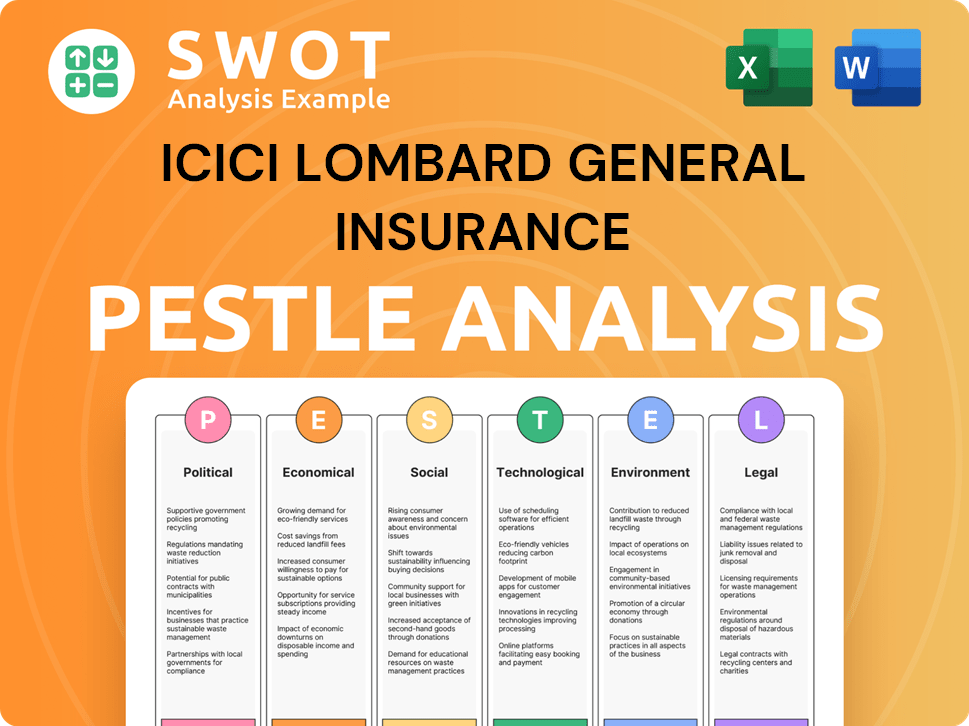
Who Sits on ICICI Lombard General Insurance’s Board?
The Board of Directors of ICICI Lombard General Insurance Company Limited oversees the company's governance and strategic direction, reflecting its diverse ownership structure. As of early 2024, the board includes representatives from major shareholders like ICICI Bank, independent directors, and executive directors. The Chairman of the Board is often an independent director, providing an objective perspective. The board also includes managing directors and executive directors responsible for daily operations and strategic execution. The composition of the board is crucial for ensuring compliance with corporate governance best practices and the interests of all ICICI Lombard shareholders.
The board's role is vital in approving major strategic initiatives, financial results, and dividend distributions, directly impacting shareholder value and company performance. Information about the board's composition, including the names and roles of the directors, is usually available in the company's annual reports and on its investor relations website. This information is essential for understanding the company's leadership and its approach to corporate governance. The board's decisions are guided by the company's Articles of Association, the Companies Act, 2013, and SEBI (Listing Obligations and Disclosure Requirements) Regulations, 2015.
| Director Category | Description | Role |
|---|---|---|
| Executive Directors | Individuals involved in the day-to-day operations. | Responsible for strategic execution and operational management. |
| Independent Directors | Directors without any material relationship with the company. | Provide an objective perspective and ensure good governance. |
| Nominee Directors | Represent major shareholders, such as ICICI Bank. | Ensure alignment with the strategic objectives of the major shareholders. |
The voting structure at ICICI Lombard generally follows a one-share-one-vote basis, typical for publicly listed companies in India. This means that voting power is directly proportional to the number of shares held. ICICI Bank's substantial stake gives it significant voting power, but the presence of a diverse public shareholder base and independent directors ensures a degree of checks and balances. The company's shareholding pattern and the identity of its major stakeholders are key factors in understanding its governance structure. For more insights, you can explore the Marketing Strategy of ICICI Lombard General Insurance.
The Board of Directors includes representatives from major shareholders, independent directors, and executive directors.
- Voting power is proportional to the number of shares held.
- The board's decisions impact shareholder value and company performance.
- The company complies with corporate governance regulations.
- ICICI Bank is a major shareholder.
ICICI Lombard General Insurance Business Model Canvas
- Complete 9-Block Business Model Canvas
- Effortlessly Communicate Your Business Strategy
- Investor-Ready BMC Format
- 100% Editable and Customizable
- Clear and Structured Layout
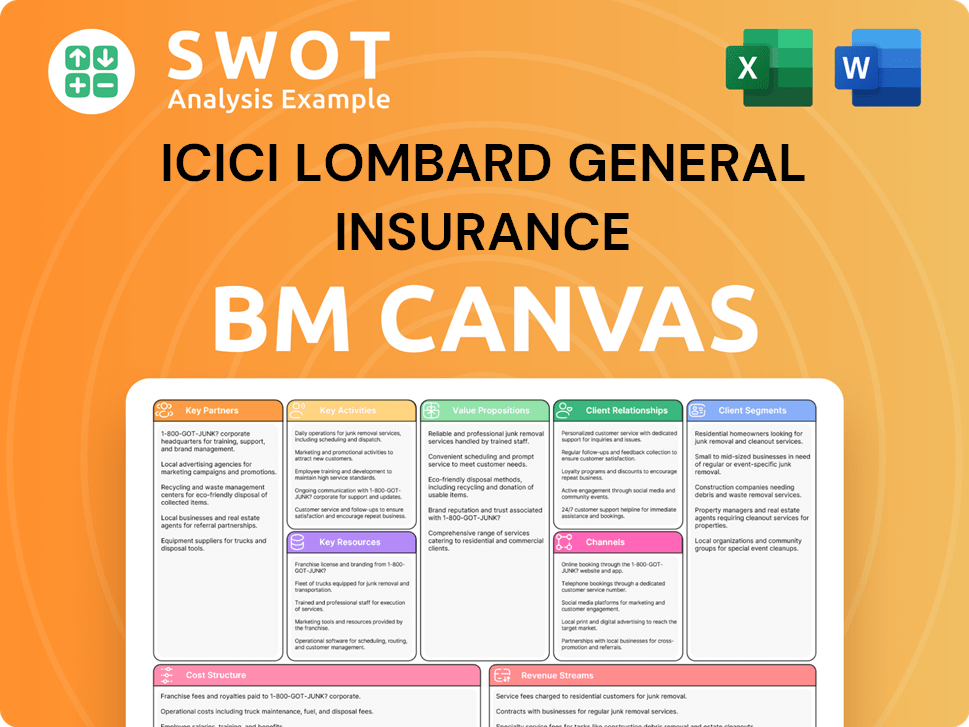
What Recent Changes Have Shaped ICICI Lombard General Insurance’s Ownership Landscape?
In the past few years, ICICI Lombard has undergone significant changes affecting its ownership and strategic direction. A key development was the acquisition of Bharti AXA General Insurance, which was finalized in 2021. This merger boosted ICICI Lombard's market share, customer base, and distribution network, strengthening its position as a leading private general insurer in India. The deal involved a share swap, leading to adjustments in the ownership structure, with Bharti AXA shareholders receiving shares in ICICI Lombard.
Another notable trend has been the gradual reduction of ICICI Bank's stake in the company. While ICICI Bank remains the main promoter and largest shareholder, its shareholding has been incrementally decreased over time. For instance, as of March 31, 2024, ICICI Bank's shareholding was approximately 48.01%. This aligns with a broader industry trend where parent companies in financial services sometimes divest assets or reduce stakes to meet regulatory requirements or optimize capital. Increased institutional investor interest also reflects confidence in its growth trajectory and market leadership. For more details, explore Target Market of ICICI Lombard General Insurance.
The company has maintained a stable and diversified public ownership base, with no major public announcements regarding immediate ownership changes. The focus remains on organic and inorganic growth, leveraging its strong market position within the general insurance sector. Industry trends, such as increased institutional ownership, continue to shape the company's governance and focus on shareholder returns.
As of March 31, 2024, ICICI Bank's shareholding in ICICI Lombard was approximately 48.01%. This reflects the company's efforts to meet regulatory requirements and unlock value. The gradual dilution of ICICI Bank's stake is a key trend.
The acquisition of Bharti AXA General Insurance in 2020, completed in 2021, significantly expanded ICICI Lombard's market presence. The merger increased its customer base and distribution network. This strategic move solidified its position as a leading insurance provider.
ICICI Lombard General Insurance Porter's Five Forces Analysis
- Covers All 5 Competitive Forces in Detail
- Structured for Consultants, Students, and Founders
- 100% Editable in Microsoft Word & Excel
- Instant Digital Download – Use Immediately
- Compatible with Mac & PC – Fully Unlocked
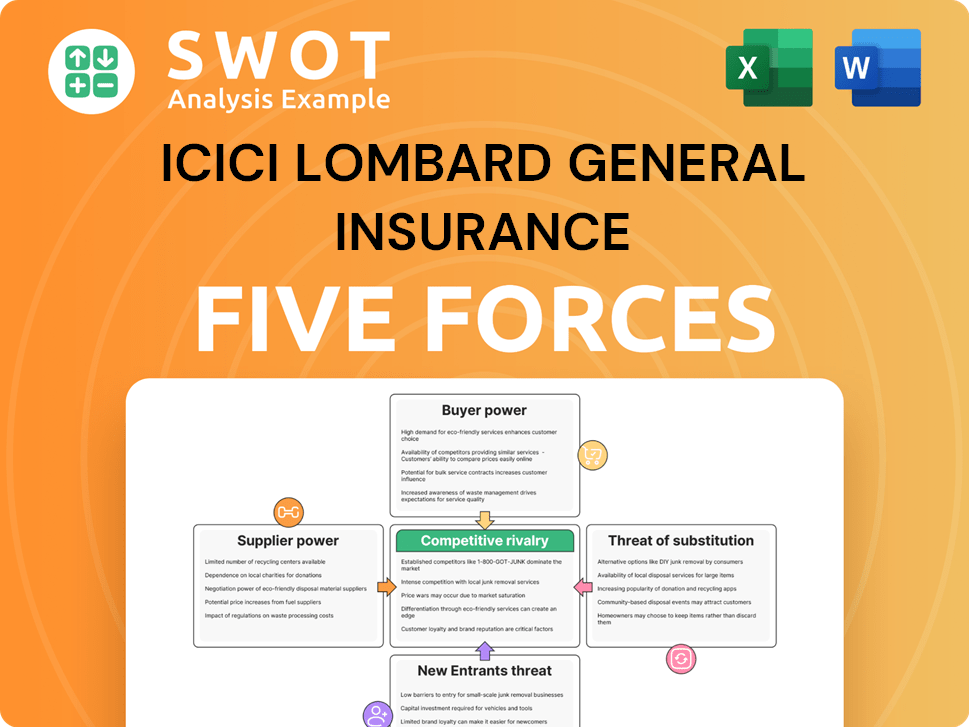
Related Blogs
- What are Mission Vision & Core Values of ICICI Lombard General Insurance Company?
- What is Competitive Landscape of ICICI Lombard General Insurance Company?
- What is Growth Strategy and Future Prospects of ICICI Lombard General Insurance Company?
- How Does ICICI Lombard General Insurance Company Work?
- What is Sales and Marketing Strategy of ICICI Lombard General Insurance Company?
- What is Brief History of ICICI Lombard General Insurance Company?
- What is Customer Demographics and Target Market of ICICI Lombard General Insurance Company?
Disclaimer
All information, articles, and product details provided on this website are for general informational and educational purposes only. We do not claim any ownership over, nor do we intend to infringe upon, any trademarks, copyrights, logos, brand names, or other intellectual property mentioned or depicted on this site. Such intellectual property remains the property of its respective owners, and any references here are made solely for identification or informational purposes, without implying any affiliation, endorsement, or partnership.
We make no representations or warranties, express or implied, regarding the accuracy, completeness, or suitability of any content or products presented. Nothing on this website should be construed as legal, tax, investment, financial, medical, or other professional advice. In addition, no part of this site—including articles or product references—constitutes a solicitation, recommendation, endorsement, advertisement, or offer to buy or sell any securities, franchises, or other financial instruments, particularly in jurisdictions where such activity would be unlawful.
All content is of a general nature and may not address the specific circumstances of any individual or entity. It is not a substitute for professional advice or services. Any actions you take based on the information provided here are strictly at your own risk. You accept full responsibility for any decisions or outcomes arising from your use of this website and agree to release us from any liability in connection with your use of, or reliance upon, the content or products found herein.